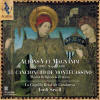Texte paru dans: / Appeared in: |
|
|
Reviewer: Mary
Berry
The conquest of Naples on June 6, 1442 was not only of political, but also of considerable cultural significance. The breadth of musical taste shown at the court of Alfonso the Magnanimous may be gauged by the variety of styles and languages contained within the source of the present recording, the Cancionero de Montecassino. This historic collection of sacred and secular music - yes 'secular', not 'profane', since any idea of irreverence or blasphemy could hardly be further from the spirit of the programme - was mercifully preserved from destruction suffered during the Second World War by the Benedictine monastery that housed it. 'What is fascinating is the cosmopolitan character of the collection, the frequent crossing of frontiers between the courtly and the popular, with pieces by both named and unnamed composers from across Europe.
The religious section opens with a solemn song of worship and mourning, Adoramnus te, well suited to the theme of the Good Friday liturgy. The soft sound of viols, harp and a quiet chamber organ, accompanying or alternating with the all-male vocal quartet, is an ideal introduction. In the settings that follow of familiar hymns and chants, alternatim features prominently, contrasting various groupings of voices high and low and period instruments, strings and wind. Damianus's Ave Maris Stella, a gently contemplative harp solo by Andrew Lawrence King, offers a brief moment of quiet repose. Another striking interlude is a vivacious Fantasia for wind and percussion.
The secular music presents an
astonishing diversity of language, form and timbre. Italian is frequently used,
with French a close second, followed by Castilian.
Musical forms include dances,
chansons , even one planctus: Ockeghem's Planctus pour la mort de Binchois.
As for diversity of
timbres, here the instrumental groupings really come into their own - usually
four of the six viols, admirably led by Jordi Savall, with a choice of other
combinations of cornett, shawm, sackbut, tuba , lute, harp, organ and
percussion. Most noteworthy is the wonderful melody Que's mi vida preguntays,
sung by the soprano Montserrat Figueras with sympatheric viol accompaniment. Top
marks, too, for the numerous more boisterous items, especially the merry
Dindirindin . |
|
|
|
|
|
Cliquez l'un ou l'autre
bouton pour découvrir bien d'autres critiques de CD |
|



